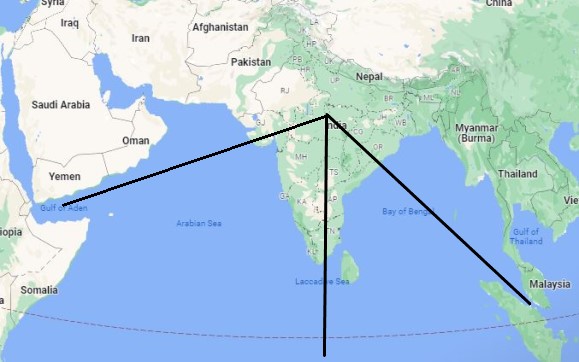* Published : 23rd Sep 2023
Wings of Steel: IAF's Daring Missions Extend India's Reach and Security
Delve into the strategic significance of the Indian Air Force's missions south of the subcontinent, reinforcing India's role as a dominant force in the Indian Ocean region.

*Not actual flight path
In a remarkable display of prowess and strategic readiness, the Indian Air Force (IAF) executed three extraordinary missions couple of months ago, each with distinct objectives and geographic significance. These missions underline the IAF's commitment to securing India's interests both within and beyond its borders.
Mission 1: Gulf of Aden - Extending India's Reach Westward
The first mission ventured to the Gulf of Aden, a region of immense importance to India's trade and energy security. It included four Sukhoi 30 MKI aircraft, a couple of Jaguars, and a C-130 strategic airlift aircraft. The Gulf of Aden serves as a crucial sea line of communication for India's exports and imports, particularly energy resources. By patrolling this area, the IAF aimed to ensure the safe passage of commercial ships carrying vital resources to and from India. The mission, with a total flying time of seven hours, spanned approximately 5,600 kilometers.
Mission 2: Eastern Indian Ocean Region - Guarding India's Eastern Frontiers
The second mission set out to explore the eastern Indian Ocean region, extending up to the Malacca Straits. It involved the newly inducted Rafale aircraft, complemented by one Sukhoi 30 MKI, another C-130 aircraft, and crucial combat enablers, including air-to-air refuelers, AWACS (Airborne Warning and Control Systems), and Airborne Electronic Warfare and Control Systems. This mission encompassed a flying time of seven hours, covering around 5,500 kilometers. It was a display of India's resolve to safeguard its eastern frontiers and protect vital sea routes.
Mission 3: Southern Indian Ocean - Securing the Southern Reaches
The third mission ventured south of Maldives, crossing the equator into the southern Indian Ocean. This operation included four Sukhoi 30 MKI aircraft, accompanied by combat enablers like air-to-air refuelers (IL-78), AWACS (Airborne Warning and Control Systems), and Airborne Electronic Warfare and Control Systems. These aircraft flew three degrees south of the equator, delving into the southern Indian Ocean, which is also within India's sphere of interest. The total flying time for this mission was seven hours, covering a distance of approximately 5,400 kilometers.
Implications and Objectives:
Validation of Doctrinal Concepts: These missions served to validate the IAF's strategic doctrines, emphasizing the readiness to operate over extended distances and in various challenging environments.
Crucial Role of Combat Enablers: The importance of combat enablers, such as air-to-air refuelers, AWACS (Airborne Warning and Control Systems), and Airborne Electronic Warfare and Control Systems, was underscored, as they significantly enhance the capabilities and endurance of fighter aircraft.
Human Endurance: The missions highlighted the remarkable endurance and professionalism of the IAF pilots, who flew for seven hours continuously, exhibiting their dedication to safeguarding the nation.
Strategic Footprints: By executing these missions, the IAF expanded its strategic footprints, reiterating its commitment to securing India's interests not only along its borders but also in the vast Indian Ocean region.
India's Power Projection: These exercises projected India's power and capability to operate in diverse scenarios and locations, serving as a testament to India's military strength and resolve.
In conclusion, these missions exemplify the IAF's adaptability, innovation, and power projection capabilities, essential for maintaining India's security and stability in an ever-evolving geopolitical landscape.
©2023 543in5
 543in5
543in5